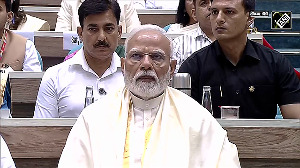Even as Intel is gradually moving its 'Intel Inside' logo out of personal computers keeping in line with the 'Leap Ahead' vision, there are moves to have a badge similar to 'Intel Inside' logo inside Asian cellphones soon. The 'Intel Inside' logo which has worked wonders for the giant chipmaker over the last 37 years is said to be the fifth largest brand in the world.
The badge is expected to help Intel make a significant dent in the mobile chips' market. The company pays equipment makers to put the badge in there and cellphone makers would not mind making extra marketing dollars.
The cellphone market is expected to grow to around one billion units over the next few years. Shipments of data- and voice-enabled devices are expected to grow to 150 million in 2007. Shipments of voice-only cell phones are expected to increase to 670 million in 2007. Even a small percentage of this market would mean new processor sales for Intel, hence, more business.
Surendra Arora, Director, Customer Solutions Group (South Asia), Intel, says: "Intel has had a number of successful design wins in the handset market over the last year and is committed to helping our original equipment manufacturer partners to promote and market their handsets. We are exploring marketing collaboration opportunities with OEMs around the world. However, we do not have any further details to share at this stage."
Since 2000, Intel has been trying to become a player in mobile phones. However, it's only over the past 18 months that it has begun to win contracts with major cellular makers.
Intel is reportedly in talks about incorporating the chips into future handsets from the world's top five makers Nokia, Motorola , Samsung, Siemens and Sony Ericsson.
After the failure of Manitoba (Intel's all-in-one processor for smart phones), it has not been able to make a significant dent in the mobile space.
Last August, Intel demonstrated its next-generation applications processor, codenamed Monahans (n the 'Hermon' platform), running at over 1ghz.
Research In Motion is using Intel's new cellular processor, the Intel(r) PXA90x (codenamed Monahans) in the BlackBerry 8700 devices, which are used on high-speed EDGE wireless networks to enable users to connect to the Internet and send and receive data with broadband-like speed.
In addition, Motorola announced plans for the Moto Q smartphone which will use an Intel application processor code-named Bulverde for applications including mobile email and Web surfing, notes Arora.
However, Intel still commands only a fraction of the market for phones. Texas Instruments holds a 50 per cent (or more) market share in the overall mobile world. It has had a close association with cellphone market leader Nokia.
Qualcomm is the other major contender. AMD and TI plan to field their own chip platforms this year, aimed at capturing a significant share in the digital home space.







 © 2025
© 2025